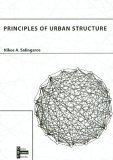Items related to Principles of Urban Structure

What people are saying:"I would also like to draw your attention to a seminal book on urban design which could fundamentally alter our approach to urban design thinking -- and directly impact our cities: 'Principles of Urban Structure' written by Nikos A. Salingaros -- a close friend and associate of Christopher Alexander. This book, in my opinion sums up that 'body of knowledge' which has simply not been integrated into our planning and architectural curriculum across the world. Many of our urban development issues arise from this. Although this book was first published in 2005, by Techne Press, Amsterdam -- it is surprising that many in the urban design field have not heard of it. It is my sincere hope that 'Principles of Urban Structure' --which is a collection of important essays, written and published over the last fifteen years in various journals, becomes the foundational text upon which present and future generations of urban planners, designers and architects build their studies and practice. In my opinion the knowledge contained in this book is capable of reconnecting our fossilized humanity with the evolving science of urban design. The lost art of city design can only be found once again through such clear thinking." ~ Mahesh P. Butani, Raise the Hammer
"synopsis" may belong to another edition of this title.
A city needs to be understood instead as a complex interacting system. Different urban networks overlap to build up a living city's dynamic complexity. This book pioneered new instruments of urban planning such as allometric scaling and power laws in city morphology, later taken up by other prominent researchers. It introduced the concepts of "fractal loading" and the brain-computer analogy. Mechanisms of emergence, information, self-organization, and adaptivity connect the fractal city on multiple levels. By showing how to relate and implement all these concepts in the city, this book contributes to the beginnings of a new urban science.
"About this title" may belong to another edition of this title.
- PublisherTechne Press
- Publication date2008
- ISBN 10 908594001X
- ISBN 13 9789085940012
- BindingPaperback
- Number of pages254
- Rating
Shipping:
FREE
Within U.S.A.
Top Search Results from the AbeBooks Marketplace
Principles of Urban Structure
Book Description Paperback. Condition: Very Good. No Jacket. May have limited writing in cover pages. Pages are unmarked. ~ ThriftBooks: Read More, Spend Less 1.09. Seller Inventory # G908594001XI4N00
Principles of Urban Structure
Book Description Softcover. Condition: Good. This book explains how cities actually work. It will serve as a guide and inspiration for planners to re-humanize our cities using the latest technologies and recent understanding from science and mathematics. The dogma of mainstream urbanism cannot cope with the changes in technology, culture and science of the last decades. The heritage we are left with is an overly asphalted and sterile concrete environment. Therefore this book addresses the needs of professional urbanists, sutdents and teachers, who wish to understand how and why cities are successful or not, depending on their form, components, and substructure. Most of the needs are related to the urgent search for new instruments of urban planning and design, to which this book contributes conceptually by showing how to connect the fractal city on multiple levels. There is an increasing awareness that a city needs to be understood as a complex interacting system. Different types of urban systems overlap to build up urban complexity in a living city. This raises the need for using concepts such as coherence, emergence, information, self-organization and adaptivity. This book relates these concepts to the city, shows how to operationalize them, and hopefully marks the beginnings of an urban science.What people are saying:"I would also like to draw your attention to a seminal book on urban design which could fundamentally alter our approach to urban design thinking -- and directly impact our cities: 'Principles of Urban Structure' written by Nikos A. Salingaros -- a close friend and associate of Christopher Alexander. This book, in my opinion sums up that 'body of knowledge' which has simply not been integrated into our planning and architectural curriculum across the world. Many of our urban development issues arise from this. Although this book was first published in 2005, by Techne Press, Amsterdam -- it is surprising that many in the urban design field have not heard of it. It is my sincere hope that 'Principles of Urban Structure' --which is a collection of important essays, written and published over the last fifteen years in various journals, becomes the foundational text upon which present and future generations of urban planners, designers and architects build their studies and practice. In my opinion the knowledge contained in this book is capable of reconnecting our fossilized humanity with the evolving science of urban design. The lost art of city design can only be found once again through such clear thinking." ~ Mahesh P. Butani, Raise the Hammer. Seller Inventory # SONG908594001X
Principles of Urban Structure (Design/science/planning)
Book Description Paperback. Condition: Very Good. Very Good. book. Seller Inventory # D8S0-3-M-908594001X-3
Principles of Urban Structure (Design/science/planning S.) Salingaros, Nikos A.
Book Description Condition: Used: Very Good. EXCELLENT CONDITION. CONTENT CLEAN, TIDY, BRIGHT AND FRESH THROUGHOUT. **SENT FIRST CLASS MAIL FROM UK STOCK.** "Always choose Readerz3, the best deal around for YOU and me !" 22. Seller Inventory # 0201Z9NMUKR

